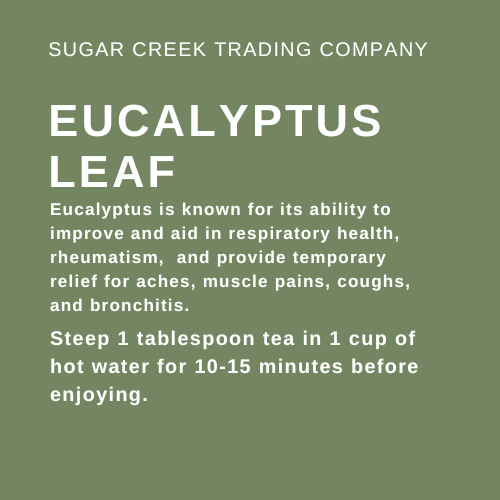Sugar Creek Trading Company
Eucalyptus Leaf
Eucalyptus Leaf
Impossible de charger la disponibilité du service de retrait
EUCALYPTUS GLOBULUS (BLUE GUM)
The Respiratory Purifier—An Herb of Lung Health, Antimicrobial Action, and Vital Energy
BOTANICAL IDENTIFICATION
Scientific Name: Eucalyptus globulus Labill.
Common Names: Blue Gum, Tasmanian Blue Gum, Fever Tree
Family: Myrtaceae
Eucalyptus globulus is a fast-growing evergreen tree reaching 30 to 55 meters in height, characterized by smooth, mottled bark, lanceolate bluish-green leaves (adult leaves 15–30 centimeters long), and solitary white flowers with numerous stamens.
Native to southeastern Australia and Tasmania, now widely cultivated in subtropical and Mediterranean climates worldwide, including California, southern Europe, South Africa, and India.
Key adaptations include drought tolerance, rapid growth in poor soils, and oil-rich leaves that deter herbivory and reduce water loss.
CULTURAL AND HISTORICAL USE
Australian Aboriginal peoples traditionally used eucalyptus leaves for fevers, wounds, and respiratory infections, preparing decoctions and inhaling steam from crushed leaves.
In the 19th century, eucalyptus gained global recognition as a fever remedy and antiseptic during malaria outbreaks in marshy regions of Europe and North Africa, earning the name "fever tree."
Modern herbalists use eucalyptus oil for respiratory relief, antiseptic wound care, and muscular pain, while its timber supports the paper and construction industries.
KEY BIOACTIVE COMPOUNDS AND BENEFITS
| Compound | Role in Plant | Human Benefits | Regional Variation |
|---|---|---|---|
| Eucalyptol (1,8-Cineole) | Volatile monoterpene | Expectorant, antimicrobial, anti-inflammatory | Highest in Australian ecotypes |
| Alpha-pinene | Terpene | Bronchodilator, antibacterial | Varies with soil and climate |
| Tannins | Polyphenols | Astringent, supports mucosal healing | Consistent across regions |
| Flavonoids | Antioxidants | Protect tissues from oxidative stress | Elevated in wild stands |
These compounds synergistically clear mucus, reduce microbial load, and soothe inflamed respiratory tissues.
HOW IT WORKS IN THE BODY
Eucalyptol and alpha-pinene act as bronchodilators and mucolytics, improving airway clearance and reducing cough frequency.
Antimicrobial actions inhibit bacterial and fungal growth, particularly Staphylococcus aureus, Streptococcus pneumoniae, and Candida albicans.
Inhalation stimulates cold receptors in the nasal passages, enhancing the sensation of clearer breathing.
Clinical studies show that 200 mg of standardized eucalyptus extract improves bronchitis symptoms and airway function within 4 to 7 days.
DOSE GUIDELINES
| Preparation Type | Typical Dose | Purpose |
|---|---|---|
| Essential Oil (inhaled) | 2–5 drops in steam or diffuser | Clear sinuses, ease bronchitis, antimicrobial vapor |
| Diluted Oil (topical) | 3–5% dilution in carrier oil | Relieve muscle pain, support wound healing |
| Infusion (leaf) | 1–2 grams in hot water, inhaled or drunk | Support colds and sore throat |
Essential oil should never be ingested without professional supervision due to potential toxicity.
PREPARATION AND USES
Traditionally prepared as a leaf infusion or poultice for chest congestion and infected wounds.
Modern uses focus on essential oil inhalation (steam therapy, diffusers) and topical blends for muscle aches and respiratory relief.
Eucalyptus oil is a common ingredient in throat lozenges, chest rubs, antiseptic mouthwashes, and cough syrups.
In aromatherapy, eucalyptus provides an invigorating, clarifying scent that uplifts energy and focus.
OPTIMAL CONTEXT FOR USE
Most effective when used at the onset of respiratory infections, during seasonal allergies, or to ease bronchitis and sinusitis.
Australian-grown eucalyptus produces the highest eucalyptol content; Mediterranean varieties offer more balanced terpene profiles.
Safe for adults and adolescents. Use cautiously in children under 6 and avoid in infants due to respiratory sensitivity.
SUSTAINABILITY AND ETHICAL HARVESTING
Commercial eucalyptus plantations risk habitat displacement and soil depletion if monocultured without regenerative practices.
Ethical sourcing emphasizes sustainable forestry, organic cultivation, and multi-species plantations to protect ecosystems.
Wild stands in Australia are managed through conservation programs balancing essential oil production with habitat preservation.
SAFETY AND CAUTIONS
Contraindicated for internal use in pregnancy and in children under age 6 due to risk of respiratory spasms.
May interact with CNS depressants and asthma medications.
Essential oil toxicity can cause nausea, seizures, or respiratory distress if ingested undiluted or used improperly.
Topical application requires dilution to prevent skin irritation. Discontinue use if coughing worsens or allergic reaction occurs.
REFERENCES
Southwell I, et al. (2003). Australian Essential Oil Profiles.
European Medicines Agency (2015). Eucalyptus globulus Leaf Monograph.
Clinical studies on bronchitis and sinusitis relief: PMID 23823960, 25643975.
Traditional Uses: Lassak EV, McCarthy T. (2011). Australian Medicinal Plants.
FINAL NOTE
Eucalyptus globulus is a tree of clarity and cleansing, offering breath to the congested and resilience to the vulnerable. Used respectfully, it clears both airways and space, restoring vital energy. Harvest with care, distill with integrity, and apply with wisdom.
Share

